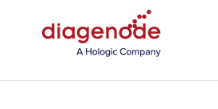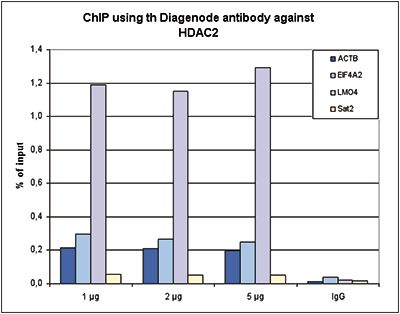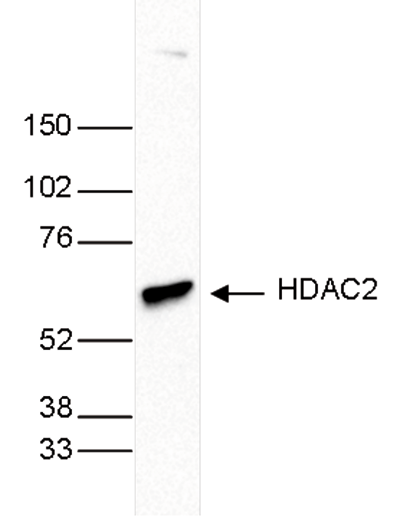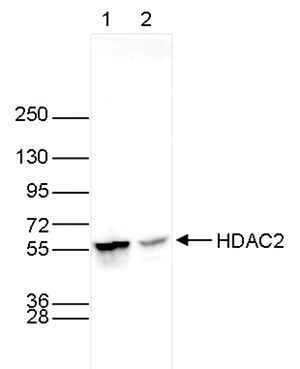
HDAC2 monoclonal antibody
| 貨號(hào) |
C15200201 |
售價(jià)(元) |
咨詢 |
| 規(guī)格 |
50ug |
CAS號(hào) |
|
- 產(chǎn)品簡(jiǎn)介
- 相關(guān)產(chǎn)品
Alternative names: HD2, RPD3, YAF1
Monoclonal antibody raised in mouse against human HDAC2 (Histone deacetylase 2), using a KLH-conjugated synthetic peptide containing a sequence from the C-terminal region of the protein.
|
Lot
|
001
|
|
Concentration
|
2.0 μg/μl
|
|
Species reactivity
|
Human
|
|
Type
|
Monoclonal
|
|
Purity
|
Protein A purified
|
|
Host
|
Mouse
|
|
Precautions
|
This product is for research use only. Not for use in diagnostic or therapeutic procedures.
|
|
Applications
|
Suggested dilution
|
References
|
|
ChIP/ChIP-seq *
|
1 μg/IP
|
Fig 1, 2
|
|
Western Blotting
|
1:1,000
|
Fig 3, 4
|
|
Immunofluorescence
|
1:500
|
Fig 5
|
* Please note that the optimal antibody amount per IP should be determined by the end-user. We recommend testing 1-5 μg per IP.
-
Validation Data
Figure 1. ChIP results obtained with the Diagenode monoclonal antibody directed against HDAC2
ChIP assays were performed using human HeLa cells, the Diagenode antibody against HDAC2 (Cat. No. C15200201) and optimized PCR primer sets for qPCR. ChIP was performed with the “iDeal ChIP-seq” kit (Cat. No. C01010055), using sheared chromatin from 4 million cells. A titration of the antibody consisting of 1, 2 and 5 μg per ChIP experiment was analysed. IgG (2 μg/IP) was used as negative IP control. QPCR was performed with primers for the ACTB, EIF4A2 and LMO4 genes, used as positive controls, and for the Sat2 satellite repeat, used as negative control. Figure 1 shows the recovery, expressed as a % of input (the relative amount of immunoprecipitated DNA compared to input DNA after qPCR analysis).
Figure 2. ChIP-seq results obtained with the Diagenode monoclonal antibody directed against HDAC2
ChIP was performed on sheared chromatin from 4 million HeLa cells using 1 μg of the Diagenode antibody against HDAC2 (Cat. No. C15200201) as described above. The IP’d DNA was subsequently analysed on an Illumina HiSeq. Library preparation, cluster generation and sequencing were performed according to the manufacturer’s instructions. The 51 bp tags were aligned to the mouse genome using the BWA algorithm. Figure 2 shows the enrichment along the complete sequence and a 2 Mb region of human chromosome 3 (fig 2A and B), and in a two genomic regions surrounding the LMO4 positive control gene and the MAGEC1 gene (figure 2C and D).
Figure 3. Western blot analysis using the Diagenode monoclonal antibody directed against HDAC2
Whole cell extracts from HeLa cells (25 μg) were analysed by Western blot using the Diagenode monoclonal antibody against HDAC2 (Cat. No. C15200201) diluted 1:1,000 in TBS-Tween containing 5% skimmed milk. The position of the protein of interest is indicated on the right (expected size: 55 kDa); the marker (in kDa) is shown on the left.
Figure 4. Western blot analysis using the Diagenode monoclonal antibody directed against HDAC2
Whole cell extracts (40 μg) from HeLa cells transfected with HDAC2 siRNA (lane 2) and from an untransfected control (lane 1) were analysed by Western blot using the Diagenode antibody against HDAC2 (Cat. No. C15200210) diluted 1:1,000 in TBS-Tween containing 5% skimmed milk. The position of the protein of interest is indicated on the right (expected size: 55 kDa); the marker (in kDa) is shown on the left.
Figure 5. Immunofluorescence using the Diagenode monoclonal antibody directed against HDAC2
HeLa cells were stained with the Diagenode antibody against HDAC2 (Cat. No. C15200201) and with DAPI. Cells were fixed with 4% formaldehyde for 10’ and blocked with PBS/TX-100 containing 5% normal goat serum and 1% BSA. The cells were immunofluorescently labelled with the HDAC2 antibody (left) diluted 1:500 in blocking solution followed by an anti-mouse antibody conjugated to Alexa594. The middle panel shows staining of the nuclei with DAPI. A merge of the two stainings is shown on the right.










